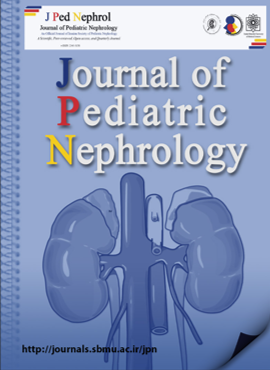Causes of Erythropoiesis-Stimulating Agent Resistant Anemia in Children with Chronic Kidney Disease at a Tertiary Hospital
Journal of Pediatric Nephrology,
Vol. 7 No. 4 (2019),
29 December 2019
,
Page 1-3
https://doi.org/10.22037/jpn.v7i4.26663
Abstract
PBackground and Aim: Routine clinical and laboratory assessments facilitate the diagnosis of erythropoietin (EPO) resistant anemia. Resistance to erythropoietin (EPO) rarely occurs in children with chronic kidney disease (CKD). It may be caused by several factors, such as poor compliance, hyperparathyroidism, malnutrition, inadequate dosages, and medication. This study was conducted to evaluate the frequency and causes of EPO resistant anemia in CKD children.
Methods: This observational retrospective study was performed in Ali Asghar Children’s Hospital in 2008. Children who were treated by EPO and still had hemoglobin concentrations (Hb) below 10 g/dl or required very high erythropoietin doses (more than 150 IU/kg/week) were considered as EPO resistant anemic cases. Therefore, their data including demographic data, EPO dosage, medications, underlying diseases, mode of dialysis, and lab test results were collected from their medical records.
Results: The Hb concentration was below 8 g/dl in eight cases (40%). The male to female ratio was 1.66 and the median age was 7.9 years old. The median hemoglobin concentration was 6.25 g/dL. Three patients (37.5%) were true cases of resistance in EPO (two patients had bone marrow fibrosis due to hyperparathyroidism and one had EPO Ab) while five cases (62.5%) received inadequate doses of EPO (anemia improved upon an acceptable EPO dosage).
Conclusion: True resistance to erythropoisis stimulatin agent is not frequent and because of there are heterogeneous causes for Lack of appropriate response to EPO, so full investigation is needed especially complete history to find the underlying reason.
Keywords: Anemia; Chronic Kidney Disease; Erythropoietin.
- Erythropoietin
- Anemia
- chronic kidney disease
How to Cite
References
Krishnan AR, Trinder D, Chua AC, Chakera A, Ramm GA, Olynyk JK. Anaemia of chronic kidney disease: What we know now. Journal of Renal and Hepatic Disorders. 2017;1(1):11-9.
Vlatkovic V, Risovic I, Popovic-Pejicic S, Vojvodic D. SP375 ASSOCIATION OF LEPTIN LEVEL AND ERYTHROPOIESIS-STIMULATING AGENTS HYPORESPONSIVNESS IN CHRONIC HEMODIALYSIS PATIENTS. Nephrology Dialysis Transplantation. 2019;34(Supplement_1):gfz103. SP375.
Bae MN, Kim SH, Kim YO, Jin DC, Song HC, Choi EJ, et al. Association of erythropoietin-stimulating agent responsiveness with mortality in hemodialysis and peritoneal dialysis patients. PloS one. 2015;10(11):e0143348.
Hayashi T, Joki N, Tanaka Y, Iwasaki M, Kubo S, Matsukane A, et al. Resistance to Erythropoiesis-Stimulating Agents in Pre-Dialysis and Post-Dialysis Mortality in Japanese Incident Hemodialysis Patients. Blood purification. 2019;47(2):31-7.
Kanbay M, Perazella MA, Kasapoglu B, Koroglu M, Covic A. Erythropoiesis stimulatory agent-resistant anemia in dialysis patients: review of causes and management. Blood purification. 2010;29(1):1-12.
Jacović S, Jovanović M, Hamzagić N, Pavlović R, Petrović D. Erythropoietin Resistance in Hemodialysis Patients. Acta facultatis medicae Naissensis. 2019;36(1):5-14.
Elliott J, Mishler D, Agarwal R. Hyporesponsiveness to erythropoietin: causes and management. Advances in chronic kidney disease. 2009;16(2):94-100.
Panichi V, Rosati A, Bigazzi R, Paoletti S, Mantuano E, Beati S, et al. Anaemia and resistance to erythropoiesis-stimulating agents as prognostic factors in haemodialysis patients: results from the RISCAVID study. Nephrology Dialysis Transplantation. 2011;26(8):2641-8.
- Abstract Viewed: 273 times
- PDF Downloaded: 127 times

